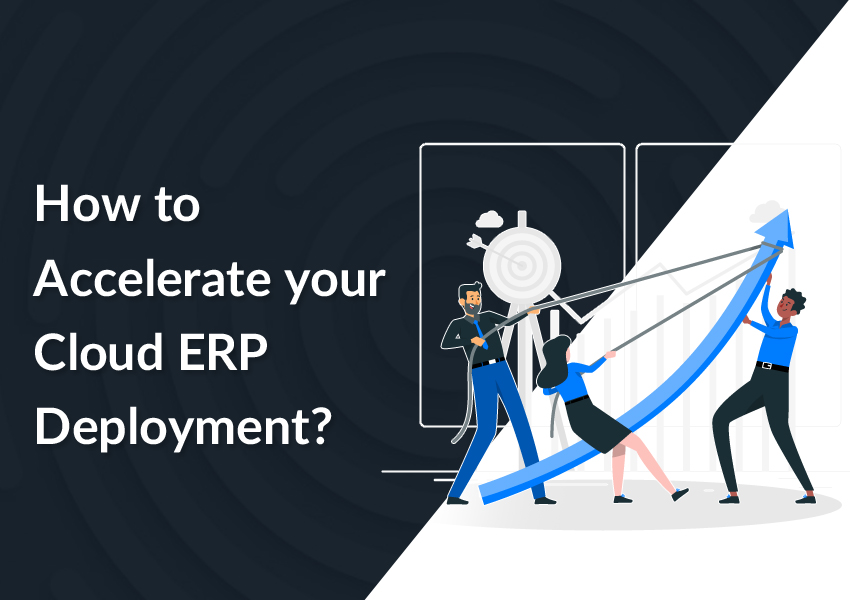Blog
How to accelerate your Cloud ERP Deployment?

According to Gartner, “By 2024, businesses will be compelled to accelerate digital business transformation and Cloud migration plans by at least five years to thrive in a post-COVID-19 environment that entails permanently increased usage of remote work and digital touchpoints.”
While most businesses faced disruption due to the pandemic, organizations using Cloud-based applications and systems continued to operate with the same agility and efficiency. The transition to Cloud ERP opens up more opportunities for innovation. In the ever-changing market conditions, it enabled organizations to become more adaptable and resilient.
We’ve entered a new era, and there’s a resurgence of interest in Cloud ERP. Here are some facts that make the case for implementing Cloud ERP even more compelling.
According to a recent IDG Cloud Computing Survey, 81% of businesses have already moved their applications to the cloud. This means that companies are increasingly recognizing the value of a smart Cloud environment over monolithic systems.
Upon discussion on Cloud Migration, Microsoft CEO Satya Nadella stated that they have witnessed two years of digital transformation in just two months.
However, it is important to understand that cloud migration isn’t just about moving to the cloud; it should result in a constant reinvention of your business processes.
A cloud-based enterprise resource planning (ERP) solution can offer a plethora of advantages to your company. It can help you optimize your business processes, increase efficiency, minimize redundancies, improve client retention, boost revenues, and provide critical reporting to help you make better business decisions. With all of your data in the cloud, everyone has instant access to the same information.
Over time, many organizations experience a considerable return on investment (ROI) on their cloud-based ERP system. Our experience over the last 20 years as an implementation partner has taught us that efficiency and productivity will boost a company’s ROI in the short run. But, more importantly, their ROI improves over time as they become more familiar with the systems, discover new capabilities, and modify their system to fully utilize their ERP solution.
Whether you’re just starting to consider moving to an ERP system, are in the planning stages, or have already started working on your implementation, here is everything you need to know to accelerate your Cloud ERP deployment.
Basic ERP Cloud Considerations
When evaluating the Cloud ERP potential, keep in mind the same factors you would when evaluating any big technological change:
- Keep track of how your business and its needs are likely to evolve and grow over the next few years.
- Collaborate with stakeholders from the executive team, business groups, and IT to define goals and purposes, analyze possible solutions, evaluate deployment plans, and ensure that the new technology is aligned with the company’s goals.
- Find a solution that matches your organization, operations, and industry, as well as the manageability, flexibility, and scalability you’ll need to support your firm’s growth.
- Find a technology provider who has a lot of experience in your field and is familiar with your type of business.
- Request your technology partner to assist you in comparing the costs and capabilities of your ERP deployment and infrastructure, including the ERP system itself, industry-specific solutions, integrations, data migrations, change management, training, and support, both in the cloud and on-premise.
What are the benefits of moving to Dynamics 365 in the cloud?
Dynamics 365 allows you to:
1. Boost Collaboration and Productivity
With more companies using remote workers, digital accessibility boosts productivity and facilitates real-time data sharing. Since employees can access and modify data from any device, anytime, anywhere, your users will be equipped with the most up-to-date productivity and mobility capabilities. Teams can also share documents effortlessly, which encourages collaboration and promotes cultural change.
2. Reduced Total Cost of Ownership
Most on-premises options are more expensive than using the cloud. Many firms using on-premise solutions require costly management, hardware, and third-party goods. Moving to the cloud can help you avoid the high costs and security risks of traditional storage and disaster recovery.
3. Enable Scalability and Adaptability
You can modify and grow your teams and business strategy without having to make costly IT infrastructure upgrades if you can swiftly activate and deploy additional users.
4. Bring all of your information together
Instead of juggling disparate data from customer relationship management (CRM) and enterprise resource planning (ERP), get a 360-degree view of your organization with a single solution. Instead of jumping from one point solution to another, users will get an all-in-one solution with a suite of tools.
Microsoft Office 365 and Microsoft Power BI both give you more control and insight into your data. With data-driven insights, employees may become more empowered decision-makers.
5. Enhance the security, privacy, and dependability of your system
For those who prefer to stay on-premise, security breaches and non-compliance are huge business concerns. Microsoft owns and operates cutting-edge data centers where your data is safely stored under a 99.9% uptime service-level agreement (SLA). End-to-end protection from Microsoft continually monitors any emerging worldwide cybersecurity risks that could jeopardize your company’s success.
What is the best way to Implement Dynamics 365 Cloud ERP?
Dynamics 365 Business Central is one of the most popular ERP systems on the market. Over 80% of Dynamics 365 users have chosen cloud deployment. There are, however, several approaches to implementing a new ERP system like Dynamics 365 Business Central.
Your business will be considerably impacted by the deployment option you select. You have three deployment options with Dynamics 365 ERP: Dynamics 365 in the cloud (hosted on Azure, Microsoft’s web services platform), Dynamics 365 on-premises (hosted on your servers), and Dynamics 365 hybrid.
Here’s a step-by-step guide to getting Dynamics 365 up and running:
- Planning: The first stage is to assess your current business practices and determine which processes the new ERP system should improve or automate.
- Review: Before rolling out your new ERP software, have your project team undertake a thorough assessment of its features and capabilities to discover proficiencies and skill gaps, as well as validate which manual operations should be automated.
- Data Preparation: Determine which data needs to be converted to the new system and analyze it to eliminate any unnecessary or outdated information.
- Testing: To check system output, test accuracy, and ensure that integrations and interfaces work properly, have your project team practice with a test database that is populated with a week’s worth of accurate transaction data.
- Training: Encourage hands-on experience with the latest software in addition to testing the new system to support company-wide training, whether in-person training, e-learning or both.
- Roll out: Plan on receiving a lot of inquiries on the day of the deployment. Ensure that your team is ready to make necessary changes and adjustments.
- Evaluation: After the rollout, compare the output of your ERP solution to the goals and objectives stated by your project team during the planning stage.
Conclusion
At DynamicsSmartz, we have vast experience in a range of industries and have successfully implemented Microsoft Dynamics 365 solutions for a variety of businesses. With our expertise, we can assist you in determining the best ERP solution and strategy for your company. For a seamless cloud ERP implementation or migration, drop us a line.
Categories
- Upgrade
- United States
- United Arab Emirates
- Power BI
- Power Automate
- Partner Program
- Office 365
- Migration
- Industry Updates And Events
- Implementation
- Dynamics SL
- Dynamics NAV
- Dynamics GP
- Dynamics Business Central
- Dynamics 365 for Sales
- Dynamics 365 Field Service
- Dynamics 365
- CRM and ERP
- Construction365
- Australia
- Artificial Intelligence
Recent Posts
- Why Sales Processes Matter in Dynamics 365 CRM
- Dynamics 365 Sales vs Customer Service: What are the key differences?
- AI for Different Industries in D365 (2025 Update): Transforming Future
- AI-Powered Revolution: Dynamics 365 in the Age of Intelligent Automation
- The Dawn of Agentization in Dynamics 365 and Beyond with Microsoft Copilot








